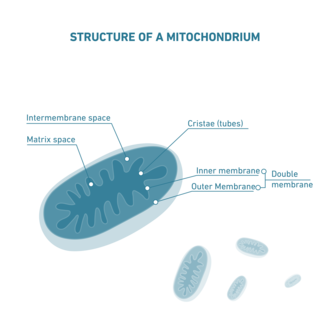The mitochondria are tiny cell organelles that are full of wonders. Under electrical voltages that we would literally find hair raising, these fascinating cellular power plants can generate 10,000 to 50,000 times more energy than the sun – in relation to their weight. Reason enough to end the mitochondrial shadow existence and start a dive into the world of mitochondria with our scientific spotlight.
What are the mitochondria?
The mitochondria are tiny cell organelles* that are found in all the cells in our bodies, with the exception of red blood cells. Often referred to as the “power plants of the cells”, these midgets, measuring approx. 0.75 to 3 μm, really live up to their name. Just as a wind turbine can convert air movements into electricity, mitochondria can convert nutrients from our diets into a form of energy that our cells use (= “ATP”).
Not every cell houses the same number of mitochondria. In fact, their number varies depending on the metabolic activity and energy requirement of the respective organ.
The mitochondria are particularly dense in nerve, muscle, sensory cells and ovules,
in particular. For example, several thousand mitochondria work in a single heart muscle cell, and can achieve a volume share of ~36%, believe it or not. However, the top performer when it comes to mitochondria is mature ovules, which can include up to 100,000 mitochondria.
*What is an organelle?
An organelle is a delimited area within a cell that has a specific function.
Function and tasks in the body
From heart beat to breath – our bodies rely on a constant supply of energy. In order to prevent our “life energy” from running dry, our mitochondrial network produces approximately as much ATP (= usable metabolic energy) as our respective body weight every day. The tireless cell power plants are never granted a break. In fact, we would only have a few seconds to live in the event of an abrupt interruption of ATP formation.
It is therefore all the more important that the energy production in the mitochondria, which is vital for us, remains constantly in action.
Cellular respiration – energy generation in the mitochondria
Now, once we take a closer look at the bean to rod-shaped cell structures, it becomes apparent that the energy generation from the nutrients – called cellular respiration in the jargon – takes place in several steps:
- glycolysis
- oxidative decarboxylation
- the citrate cycle and
- the respiratory chain.
In the respiratory chain, the last step in cell respiration, the energy released in advance is briefly stored on small “energy batteries” (= ATP), which are immediately used for the metabolic processes of the cell.
Other tasks and functions
In addition to their prime role as cell power plants, the mitochondria also fulfil other important tasks. They are involved in cell growth, cell communication, programmed cell death (apoptosis), immune response, oxidative balance and the production of our red blood cells as well as our sex hormones, among other things.
For smart alecs! The four most important types of mitochondria are called the...
- Cristae
- Sacculus
- Prism and
- Tubule
...types.
Fatigue and its relationship with the mitochondria
Our body houses 30 trillion cells, each with hundreds to tens of thousands of mitochondria. This dynamic mitochondrial network provides us with constant energy. However, just as the batteries of mobile phones, laptops and the like eventually get worn out, our mitochondria are not made to last forever.
At around the age of 30 the number and activity of the mitochondria begin to slow down. Stress, environmental toxins, sleep deprivation and malnutrition can add to the work load of the mitochondrial network. All of these processes are also reflected in energy levels over the short or long term. As we age, energy and performance decline, and general fatigue creeps in.
This negative development can be attributed, among other things, to the fact that damage to the proteins and DNA accumulates in the mitochondria over the years, which leads to functional disorders (= "mitochondrial dysfunction"). While only a few years ago, scientific opinion posited that mitochondrial dysfunction was a rare metabolic defect, many physicians and researchers are now focusing precisely on this disorder. Mitochondrial dysfunction appears to play a role not only in the aging process, but also in the development of age-related diseases (e.g. neurodegenerative diseases, cardiovascular diseases).
The structure of the mitochondria and their development
The mitochondria are one of the smallest cell organs with an average size of approx. 0.75 to 3 μm. These structures are easily recognisable by their oval shape and double membrane (= separating layer) on cell images. The double membrane is smooth to the outside, but folded to the inside, which results in compartmentalisation – i.e. two spaces separated from each other – the matrix space that is in the middle, and the intermembrane space that lies between the matrix space and the outer membrane.

Due to the strong folding of the inner membrane, a particularly large surface is achieved, which offers space for countless biochemical processes. In the intermembrane space, in turn, there are various substances and enzymes that can be exchanged with the surrounding area by the outer membrane.
Mitochondrial DNA: A genetic material with history
Mitochondria are different. Unlike other organelles, they are not only surrounded by a double membrane, but they also have their own DNA. But where does this come from?
Today’s science assumes that more than 1.6 billion years ago, the precursors of our cells formed a symbiosis with archaebacteria – a form of “sub-tenant” – which today, having developed into mitochondria, play a key role in cell metabolism. The former archaebacteria still have their own DNA (= mitochondrial DNA), which contains information that is different from our normal genetic material.
While the structure of the mitochondrial DNA is much shorter than that of the nucleus,
it is present in multiple copies. This special feature allows the mitochondria to multiply independently and separately from the cell. Similar to bacteria, this results in a cross-division in which an exact copy of the genetic information is passed on.
Fun Fact: Bacteria amongst themselves
Like leopards, mitochondria cannot change their spots. They communicate with each other in a completely “bacterial-like” manner across the body, distributing mitochondrial stress as well as positive “vibes”. And the mitochondria are in constant exchange even with our intestinal bacteria.
Mitochondrial dysfunction – cellular power plants in difficulties
Energy generation in the mitochondria usually runs like clockwork in our youth. However, over the years, excessive oxidative or nitrosative stress can threaten the delicate cellular power plants and cause damage to their structure and genetic makeup.
If this damage progresses, fully fledged mitochondrial dysfunction can occur, which not only leads to a deterioration in energy production, oxidative stress and systemic inflammation, but also to palpable symptoms. These include, among others, symptoms of exhaustion, concentration and memory disorders as well as muscle complaints. In addition, medical research makes it increasingly clear that mitochondrial dysfunction also plays a role in the development of age-related diseases such as diabetes, cardiovascular diseases and neurodegenerative diseases.
Strengthening the mitochondria
The good news is that we don’t have to simply watch our mitochondria “go downhill”. There are simple ways to strengthen the tiny cell power plants and to keep them in the best possible condition.
1. Healthy diet – low in sugar, high in nutrients
As with many health concerns in life, the right diet is crucial for our mitochondria.
The food that tastes best in the long term for our cellular power plants should be rich in vital substances, low in pollutants and take into account the glycaemic index. While the mitochondria burn sugar to generate energy, a constant excess of sugar can promote insulin resistance and interfere with the mitochondrial metabolism.
A healthy diet rich in fruits, vegetables and healthy fats provides ample mitochondrial-friendly micronutrients that our cellular power plants desperately need as protective materials. These nutrients can also be taken in targeted form as nutritional supplements.
2. Mitochondrial supplementation
Strengthening the mitochondria with coenzyme Q10
Coenzyme Q10 (CoQ10) is important for our mitochondria in two equally vital ways: On the one hand, the vitamin-like substance serves as a type of ignition spark that sets in motion the chain reaction in the mitochondria. On the other hand, CoQ10 has an antioxidant effect, protecting our cellular power plants from free radical damage.
Although coenzyme Q10 can be manufactured to a certain extent by our body itself,
this ability tends to peter out after the 30th year of age. At the same time, over the years we also lose performance, vitality and energy. The targeted intake of coenzyme Q10 or its active form "ubiquinol" can help to keep the Q10 status at its optimum.
Mitochondrial materials: B vitamins, magnesium, etc.
To get the most out of energy generation, the mitochondria need not only “fuel” (e.g. carbohydrates), but also a range of materials (cofactors) in the form of special micronutrients. These include, for example, certain B vitamins (e.g. vitamin B1, B2, B3, B12), magnesium, iron, copper, manganese and alpha lipoic acid. If a material deficiency occurs, our cell power plants can no longer function smoothly – their energy yield decreases.
Mitochondrial protective agents – antioxidants
Cell respiration produces free radicals that can be used for various processes in the body (e.g. immune defence). To a certain extent, however, excessive radical formation causes oxidative stress, which can lead to damage to cells and cell structures (e.g. the mitochondria). The mitochondria are equipped with a potent shield to counteract possible radical damage. This also includes a team of antioxidants, such as coenzyme Q10, vitamin C, vitamin E and alpha lipoic acid.
3. Activate the mitochondria with exercise and sport
Endurance sports not only strengthen our muscles, they also train the mitochondria and encourage them to grow. A mechanism that has a certain logic on closer inspection! Because at the end of the day, our cellular power plants must ensure that our organism does not run out of “puff” when energy is required. However, it is noteworthy that not only do the muscle fibres gain mitochondria through sport, but this also has an effect on the brain.
4. Fasting as a mitochondrial cleansing process
Fasting not only helps our bodies to lose excess kilos, it can also free them from defective mitochondria and stimulate the formation of new cellular power plants.
The so-called autophagia can be triggered in cells by fasting. This self-cleaning programme works with and recycles all organelles (such as mitochondria) when disposing of defective proteins. This is important for the vitality of the cells, as defective mitochondria (or other damaged material) put a strain on our cell health and in the worst case scenario can cost it dearly.
5. Strengthening the mitochondria during sleep
Sleep is incredibly important, not only for our personal well-being, but also for the vitality of our mitochondria. After all, the body uses this break to regenerate both our body and our brain. Studies show that a lack of sleep leads to increased oxidative stress and that antioxidant enzymes are less active. A connection between sleep deprivation and changes in mitochondrial structures could also be shown.


IHHT: A special form of mitochondrial training
When the air in the cells becomes thin, our organism initiates a mechanism which, among other things, is intended to ensure the longest possible survival through adapted energy generation. The so-called intermittant hypoxia-hyperoxia treatment (IHHT) makes use of this process – a very special form of mitochondrial training. In this case, low-oxygen air (hypoxia) alternating with oxygen-rich air (hyperoxia) is inhaled via a breathing mask at defined minute intervals.
Scientific studies show that the mitochondria weakened through the hypoxia begin to die. This mitochondrial death may sound counterproductive at first, but it encourages healthy mitochondria to divide and optimise their energy production. This can achieve various positive effects – including the activation of fat burning, an improvement in physical and mental resilience and the strengthening of the immune system.
Can the function of the mitochondria be seen in the blood count?
Modern laboratories now offer special measurements to assess mitochondrial function. One of the most meaningful laboratory markers here is the so-called “bioenergetic health index” (BHI), a blood test that is like a kind of performance MOT for the mitochondria. Your doctor will be happy to advise you.
Conclusion: The mitochondria are natural cellular power plants that work tirelessly to keep the amazing human body alive. Unfortunately, their power diminishes with age. This makes it all the more important to keep your body’s mitochondrial network fit with a high-energy diet, adequate sleep, endurance sports and fasting periods. In addition, the targeted intake of mitochondrial-friendly micronutrients can encourage the tiny cell power plants.
Frequently asked questions about the mitochondria
Sources:
Schniertshauer, D., Bergemann, J. 2022. Wie aus Sauerstoff Energie wird und der Funke dabei trotzdem nicht überspringt – die Besonderheiten der Mitochondrien. J. Gynäkol. Endokrinol. CH 25, 78–86 (2022). https://doi.org/10.1007/s41975-022-00245-z. https://link.springer.com/article/10.1007/s41975-022-00245-z#:~:text=So%20arbeiten%20in%20einer%20einzigen,Form%20von%20ATP%20%5B9%5D.
Li, Y., Yang, S. et al 2023. Mitochondria as novel mediators linking gut microbiota to atherosclerosis
that is ameliorated by herbal medicine: A review. Front Pharmacol. 2023 Jan 17:14:1082817. doi: 10.3389/fphar.2023.1082817. eCollection 2023.
Sangwung, P., Petersen K.F. et al. 2020. Mitochondrial Dysfunction, Insulin Resistance, and Potential Genetic Implications. Endocrinology. 2020 Apr 1;161(4):bqaa017.
https://www.wissenschaft.de/gesundheit-medizin/bakterielle-verwandte-der-mitochondrien-identifiziert/, Zugriff: 4.6.2024.
Erpenbach, K., Mücke, S. Mitochondriale Medizin. Sportärztezeitung, 03/17. https://sportaerztezeitung.com/rubriken/kardiologie/2681/mitochondriale-medizin/, Zugriff: 5.6.2024.
Grafen, K. 2021. Wenn die Luft in den Zellen dünn wird. DHZ 6/2021. https://natuerlich.thieme.de/therapieverfahren/praevention/detail/wenn-die-luft-in-den-zellen-duenn-wird-1197, 5.6.2024.
Barbiroli, B., Medori, R. et al. 1995. Lipoic (thioctic) acid increases brain energy availability and skeletal muscle performance as shown by in vivo 31P-MRS in a patient with mitochondrial cytopathy. J Neurol. 1995 Jul;242(7):472-7. doi: 10.1007/BF00873552.
He, Y., Yue, Y., et al. 2015. Curcumin, inflammation, and chronic diseases: how are they linked?. Molecules (Basel, Switzerland), 20(5), 9183–9213.
Melhuish Beaupre, L. M., Brown, G.M. et al. 2022. Mitochondria's role in sleep: Novel insights from sleep deprivation and restriction studies. The world journal of biological psychiatry: the official journal of the World Federation of Societies of Biological Psychiatry, 23(1), 1–13.
Civitarese, A.E., Carling, S. et al. 2007. Calorie Restriction Increases Muscle Mitochondrial Biogenesis in Healthy Humans. PLoS Med. 2007 Mar; 4(3): e76.









